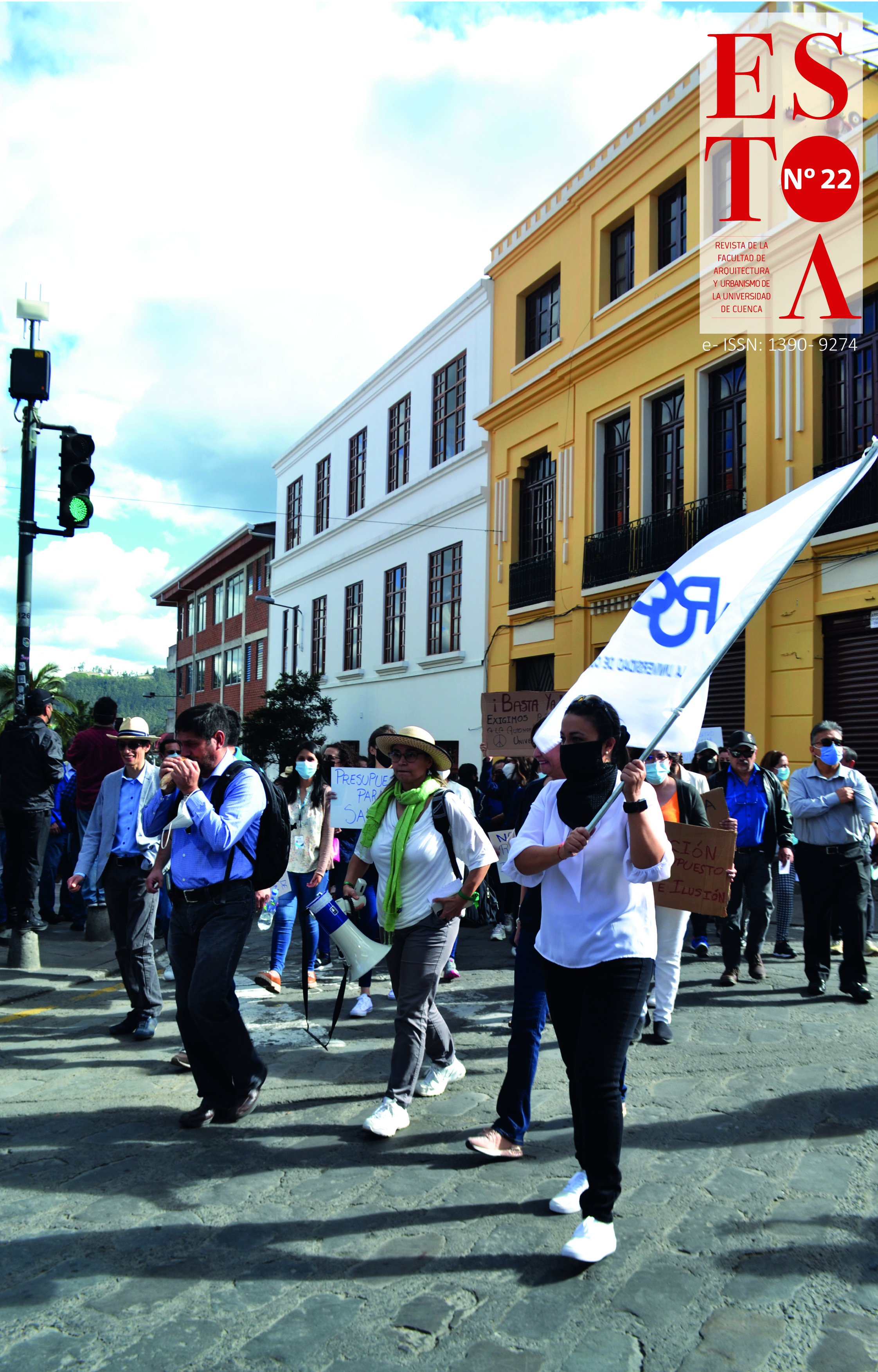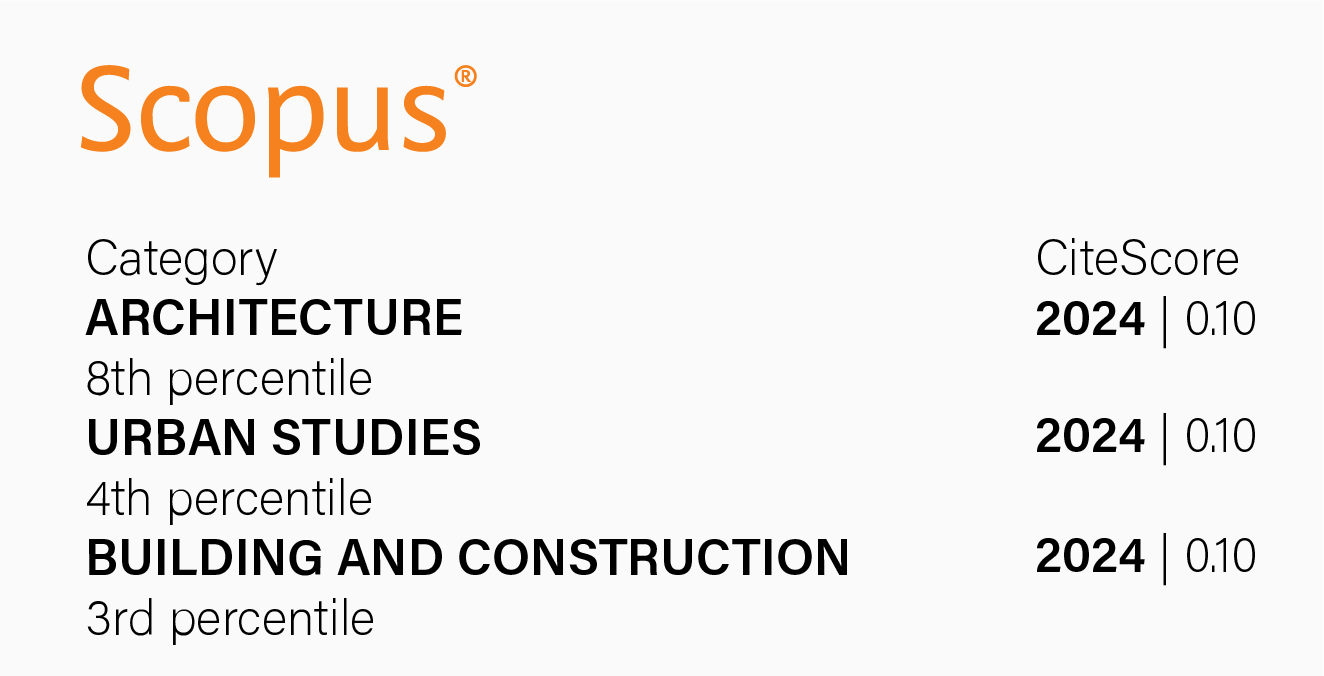Luis Monsalve's shells and hyperbolic paraboloids in Ecuador
DOI:
https://doi.org/10.18537/est.v011.n022.a09Keywords:
concrete thin shell, Todos Santos, hypar, formwork, architectural graphics, compact city/sprawled city, language, symbol, EcuadorAbstract
One year after his demise, the reinforced concrete shells of engineer Luis Alberto Monsalve Ortiz, from Cuenca-Ecuador, are discovered. His structures range from elliptical to hyperbolic paraboloids, from rectangular to hexagonal umbrellas, whether they were inverted or straight ones, from conoids to conical segments, from hyperbolic cylinders to spherical caps, and other double-curved surfaces designed and built between 1964 and 1980.
Starting with two important Monsalve's logs, his sketchbook and his constructions photo album, followed by visits to his buildings, on-site surveys, and various interviews, the globality of Monsalve's oeuvre is presented for the first time, followed by four significative case studies of his projects. His innovative work was achieved in a practice distant from traditional ones in the time and place in which he worked. Documentation and interpretation of the impact of his works on Ecuadorian engineering and architectural modernity has begun as a way of understanding our past and present. Ideally, capturing the essence of Monsalve's ideas can bring us closer to anticipating the new forms and constructive techniques of the future.
Downloads
References
Estructuras modernas (15 de octubre de 1957). El Comercio, p. 15.Chacón T., José F. (1964). Estado actual del Análisis de Placas Plegadas de Concreto Reforzado. [Tesis profesional de revalidación del Título de Ingeniero Civil obtenido en el I. T. E. S. M.-México. Facultad de Ingeniería Civil, Universidad de Cuenca].
Eljuri J., G. (2011). Expediente Técnico de Valoración Patrimonial de El Ejido de Cuenca. Instituto Nacional de Patrimonio Cultural –Dirección Zonal 6.
Espinoza, C. y Mora, C. (1981). Estudio de factibilidad para la instalación de una industria de módulos prefabricados de HORMIPULPA en la ciudad de Cuenca. [Tesis de Graduación. Universidad de Cuenca].
Faber, C. (1963). Candela / The Shell builder. Reinhold.
Garlock, M. E. y Billington, D. P. (2008). Félix Candela. Engineer, Builder, Structural Artist. Princeton University Art Museum en asociación con Yale University Press.
Hermida, M. A. (2007). Vivienda unifamiliar 1950-1979. Revista Proyectos. Colegio de Arquitectos del Ecuador, Núcleo Azuay, (1), 20-25.
Luzuriaga d., M., Carrión G. A. M., y Valladares C., A. (2019). Cascarones delgados de hormigón armado en el Ecuador. Actas del II Congreso Internacional Hispanoamericano de Historia de la Construcción, (pp. 583-595). Facultad de Arquitectura-Universidad Nacional Autónoma de México, Sociedad Española de Historia de la Construcción, Instituto Juan de Herrera, Escuela Técnica Superior de Arquitectura-Universidad Politécnica de Madrid.
Luzuriaga d., M. (2020). El paraboloide hiperbólico de concreto armado en el Ecuador. DAYA. Diseño Arte y Arquitectura, 1 (8), 233-256.
Luzuriaga d., M. (2021a). Replicating Candela´s Los Manantiales. 7th International Congress for Construction History Congress Proceedings. Taylor & Francis.
Luzuriaga d., M. (2021b). Two replicas of Candela´s Los Manantiales in Ecuador. Proceedings of the IASS Annual Symposium 2020/21 and the 7th International Conference on Spatial Structures. IASS.
Méndez P., V. (2019) Construcción de cascarones de concreto armado a través de los medios de difusión de sus constructores. Actas del II Congreso Internacional Hispanoamericano de Historia de la Construcción, (pp. 671-679). Facultad de Arquitectura-Universidad Nacional Autónoma de México, Sociedad Española de Historia de la Construcción, Instituto Juan de Herrera, Escuela Técnica Superior de Arquitectura-Universidad Politécnica de Madrid.
Muñoz R., M., y Moyano V., M. G. (2002). Arquitectura de las líneas rectas. Influencia del movimiento moderno en la arquitectura de Cuenca, 1950-1965. [Tesis de Graduación, Universidad de Cuenca.].
Peralta, E. (2019). Jorge Roura Cevallos, pionero de la arquitectura moderna en el Ecuador. Trama Revista de Arquitectura. 42, (153), 80-85.
Torroja, E. (1957). Razón y ser de los tipos estructurales. Textos Universitarios, 13. Doce Calles.
Published
How to Cite
Issue
Section
License
Copyright (c) 2022 Estoa. Revista de la Facultad de Arquitectura y Urbanismo

This work is licensed under a Creative Commons Attribution-NonCommercial-ShareAlike 4.0 International License.
The Journal declines any responsibility for possible conflicts derived from the authorship of the works that are published in it.
The University of Cuenca in Ecuador conserves the patrimonial rights (copyright) of the published works and will favor the reuse of the same ones, these can be: copy, use, diffuse, transmit and expose publicly.
Unless otherwise indicated, all contents of the electronic edition are distributed under a Creative Commons Attribution-NonCommercial-ShareAlike 4.0 International License.




